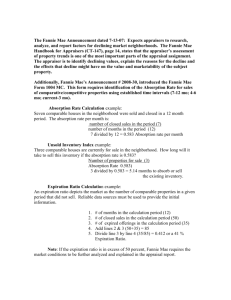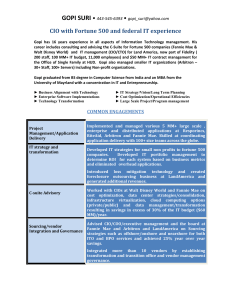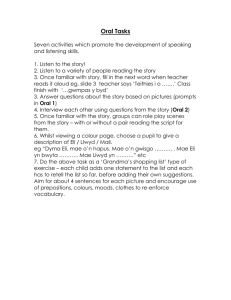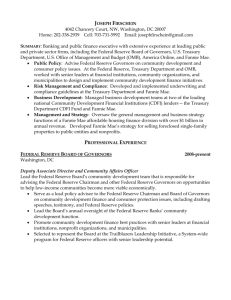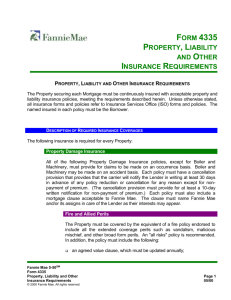FAQs – Project Standards Requirements
advertisement
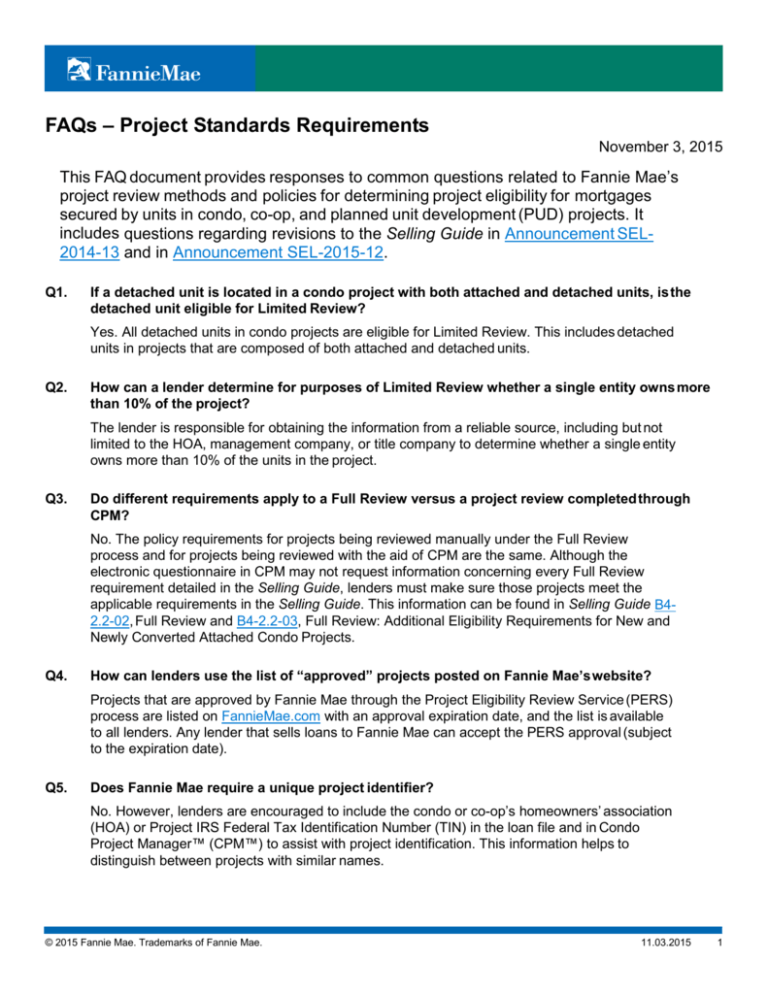
FAQs – Project Standards Requirements November 3, 2015 This FAQ document provides responses to common questions related to Fannie Mae’s project review methods and policies for determining project eligibility for mortgages secured by units in condo, co-op, and planned unit development (PUD) projects. It includes questions regarding revisions to the Selling Guide in Announcement SEL2014-13 and in Announcement SEL-2015-12. Q1. If a detached unit is located in a condo project with both attached and detached units, is the detached unit eligible for Limited Review? Yes. All detached units in condo projects are eligible for Limited Review. This includes detached units in projects that are composed of both attached and detached units. Q2. How can a lender determine for purposes of Limited Review whether a single entity owns more than 10% of the project? The lender is responsible for obtaining the information from a reliable source, including but not limited to the HOA, management company, or title company to determine whether a single entity owns more than 10% of the units in the project. Q3. Do different requirements apply to a Full Review versus a project review completed through CPM? No. The policy requirements for projects being reviewed manually under the Full Review process and for projects being reviewed with the aid of CPM are the same. Although the electronic questionnaire in CPM may not request information concerning every Full Review requirement detailed in the Selling Guide, lenders must make sure those projects meet the applicable requirements in the Selling Guide. This information can be found in Selling Guide B42.2-02, Full Review and B4-2.2-03, Full Review: Additional Eligibility Requirements for New and Newly Converted Attached Condo Projects. Q4. How can lenders use the list of “approved” projects posted on Fannie Mae’s website? Projects that are approved by Fannie Mae through the Project Eligibility Review Service (PERS) process are listed on FannieMae.com with an approval expiration date, and the list is available to all lenders. Any lender that sells loans to Fannie Mae can accept the PERS approval (subject to the expiration date). Q5. Does Fannie Mae require a unique project identifier? No. However, lenders are encouraged to include the condo or co-op’s homeowners’ association (HOA) or Project IRS Federal Tax Identification Number (TIN) in the loan file and in Condo Project Manager™ (CPM™) to assist with project identification. This information helps to distinguish between projects with similar names. © 2015 Fannie Mae. Trademarks of Fannie Mae. 11.03.2015 1 Q6. When conducting a CPM Review, is the lender required to review the project’s legal documents and budget? It depends on the type of unit securing the mortgage. The lender must review the legal documents and budget for attached units in a new condo project consisting of more than four units being reviewed through CPM. The lender must review the budget for attached units in an established condo project reviewed through CPM. Additional information on requirements for the project’s legal documents and budget can be found in the Fannie Mae Selling Guide B4-2.202, Full Review and B4-2.2-03, Full Review: Additional Eligibility Requirements for New and Newly Converted Attached Condo Projects. Q7. What is the difference between legal phases and construction or marketing phases? A project that is legally phased requires a supplement or amendment to the master deed or declaration be recorded in the public records to formally make additions to the project. Construction or marketing phases typically exist for the developer’s convenience and are covered under a single master deed or declaration. Lenders are not delegated to review construction or marketing phases, and new projects completed on a marketing or construction phase basis must be submitted to PERS for review. Q8. What is a “newly converted” condominium project? A gut or non-gut rehabilitation condominium that does not meet the criteria of “established” is considered “newly converted.” Newly converted non-gut rehabilitation projects with more than four units must be submitted to Fannie Mae for review through PERS. This requirement includes the conversion of rental buildings into individual units being marketed for sale. Q9. When calculating presales for new or newly-converted projects, do units have to be conveyed (sold) in order to count toward the total number of presales? No. Presales are calculated based on both units that are under contract and units that have been conveyed (sold and settled). Q10. How is the 10% reserve allocation in the budget calculated? To determine whether the association has a minimum annual budgeted replacement reserve allocation of 10%, divide the annual budgeted replacement reserve allocation by the association’s annual budgeted assessment income. Additional information concerning reserve calculation can be found in Selling Guide B4-2.2-02, Full Review. Q11. Are lenders permitted to use a reserve study if the association does not budget replacement reserves of 10%? Yes. The lender may use a reserve study in lieu of calculating a replacement reserve of 10% provided the following conditions are met: The lender obtains a copy of an acceptable reserve study and retains the study and the lender’s analysis of the study in the project approval file; The study demonstrates that the project has adequate funded reserves that provide financial protection for the project equivalent to Fannie Mae’s standard reserve requirements; The study demonstrates that the project’s funded reserves meet or exceed the recommendation made in the study; and © 2015 Fannie Mae. Trademarks of Fannie Mae. 11.03.2015 2 The study meets Fannie Mae’s requirements for replacement reserve studies listed in the Fannie Mae Selling Guide. Find additional requirements for reserve studies in Selling Guide B4-2.2-02, Full Review. Q12. What is the lender’s responsibility with regard to reviewing replacement reserve studies? Lenders are not required to use reserve studies for project eligibility review. Fannie Mae permits the use of a reserve study as an alternative for projects that may not meet the 10% budgeted reserve requirements. If a lender decides to use a reserve study to determine project eligibility, the lender is expected to have staff that is trained to review and analyze the reserve study. Lenders may not request that Fannie Mae review reserve studies to determine compliance with requirements with the exception of projects submitted through the PERS process or the Project Eligibility Waiver process. For more information refer to Selling Guide B4-2.2-02, Full Review. Q13. What is the lender’s responsibility for the review of legal documents? Must lenders obtain an attorney’s opinion or memorandum regarding the legal documents for new projects? For attached units in new condo projects (containing more than four units), Fannie Mae requires lenders to validate that the condo project’s legal documents are in compliance with the requirements in the Fannie Mae Selling Guide. Except for new projects submitted for Fannie Mae review via PERS, obtaining a written determination of compliance from an attorney is optional. For new and newly converted condo projects submitted for Fannie Mae review via PERS, a qualified attorney engaged by the lender must review the legal documents and determine that they are in compliance with Fannie Mae’s requirements. The determination must be documented in writing but does not need to be a formal legal opinion. The lender must complete Form 1054 and attach the attorney review as part of the PERS submission process. NOTE: Fannie Mae reserves the right to require a review of the legal documents for an established condo project submitted for Fannie Mae review via PERS. Q14. Does non-incidental business income for condo projects include lease agreements with telephone, cable, and Internet companies? Income earned by the homeowners’ association that is the result of lease agreements with telephone, cable, and Internet companies does not meet the definition of active ownership or operation of amenities or services available to unit owners and the general public. Therefore, the 15% cap (relative to the project’s operating budget) does not apply to this type of income. Selling Guide section B4-2.1-02, Ineligible Projects (Non-Incidental Business Arrangements) was updated in August 2015 to remove such lease agreements as an example of income subject to the 15% cap. Q15. Do the limitations for non-incidental income apply when the HOA is earning money from the leasing of commercial space to a business entity? When an HOA receives income because it rents a space located within its project to a business entity, the rental income is not subject to limitations for business income because the HOA is leasing the space and not “actively” operating or owning a business. The limitations for nonincidental business income apply only when the HOA earns income from actively owning or operating a business enterprise. © 2015 Fannie Mae. Trademarks of Fannie Mae. 11.03.2015 3 Q16. Can lenders submit a PUD project through the PERS process? Not generally. In most cases, the evaluation of PUD projects remains a lender-delegated function (and no project review is required for most PUD projects). However, Fannie Mae requires lenders to submit PUD projects consisting of single-wide manufactured homes for review through the standard PERS process. Lenders may contact the Project Standards team (project_standards@fanniemae.com) to address specific scenarios. Q17. How can lenders access the required forms for PERS? How should the completed project review documentation be submitted to Fannie Mae? Required forms are posted on the Fannie Mae business portal. Project review documentation should be submitted electronically to pers_projects@fanniemae.com. Q18. Does Fannie Mae allow shared amenities? Shared amenities generally are not permitted between the HOA and a third party such as the developer, sponsor, or management company. Shared amenities are allowed when two or more HOAs share amenities for the exclusive use of the unit owners. The associations must have an agreement in place governing the arrangement for shared amenities that includes: Q19. description of the shared amenities; description of the terms for sharing the amenities; provisions for the funding, management, and upkeep of the shared amenities; and provisions to resolve related conflicts between the associations. Does Fannie Mae allow the HOA to lease parking spaces for use by condo unit owners? Yes. Parking amenities provided under commercial leases or parking permit arrangements with parties unrelated to the developer are acceptable. Q20. Does Fannie Mae allow a unit owner’s parking space to be financed by the mortgage? Yes. Fannie Mae permits the financing of a single or multiple parking space(s) with the mortgage, provided that the parking space(s) and residential unit are included on one deed as evidenced by the legal description in the mortgage. In such cases, the LTV, CLTV, and HCLTV ratios are based on the combined value of the residential unit and the parking space(s). Q21. What is the review process for manufactured housing? Projects consisting of manufactured housing must be submitted to Fannie Mae via PERS for review, with the exception of multi-width manufactured homes that are part of a PUD project. A lender that would like to deliver loans secured by a project consisting of manufactured housing must contact Fannie Mae’s Project Standards team to discuss the project and PERS submission requirements. Additional Resources Visit the Condo, Co-op, and PUD Eligibility page on the Fannie Mae business portal for additional resources, including an “At-A-Glance” quick reference on condo project reviews. You may also direct questions to your customer account team, our Customer Support Center at (1-800-752-6440), or Fannie Mae’s Project Standards team (project_standards@fanniemae.com). © 2015 Fannie Mae. Trademarks of Fannie Mae. 11.03.2015 4
